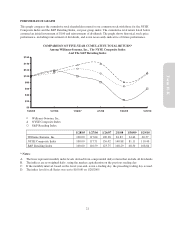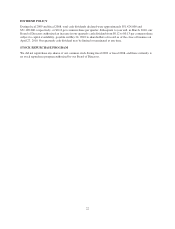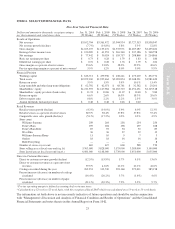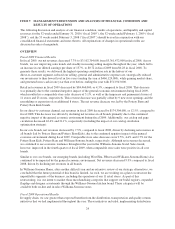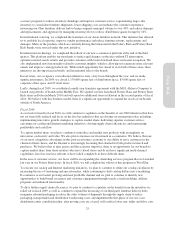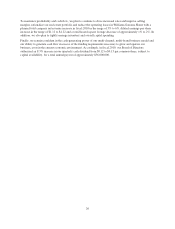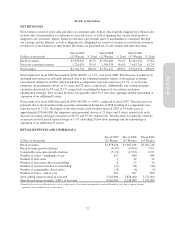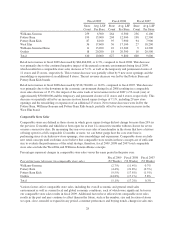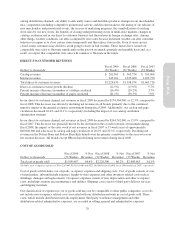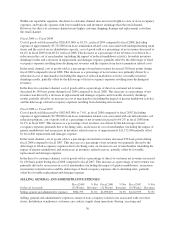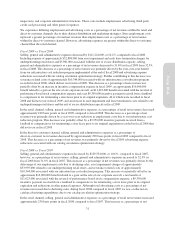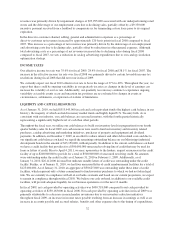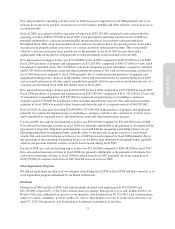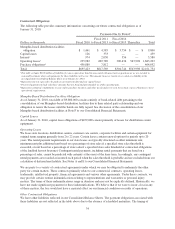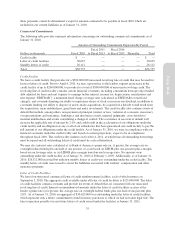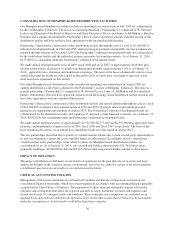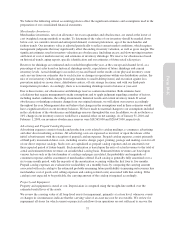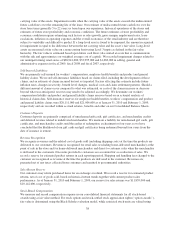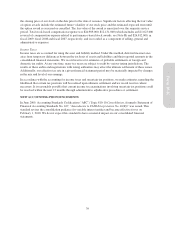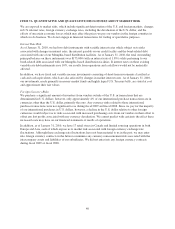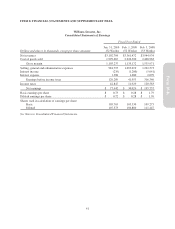Pottery Barn 2009 Annual Report Download - page 43
Download and view the complete annual report
Please find page 43 of the 2009 Pottery Barn annual report below. You can navigate through the pages in the report by either clicking on the pages listed below, or by using the keyword search tool below to find specific information within the annual report.
inspection), and corporate administrative functions. These costs include employment, advertising, third party
credit card processing and other general expenses.
We experience differing employment and advertising costs as a percentage of net revenues within the retail and
direct-to-customer channels due to their distinct distribution and marketing strategies. Store employment costs
represent a greater percentage of retail net revenues than employment costs as a percentage of net revenues
within the direct-to-customer channel. However, advertising expenses are greater within the direct-to-customer
channel than the retail channel.
Fiscal 2009 vs. Fiscal 2008
Selling, general and administrative expenses decreased by $111,224,000, or 10.2%, compared to fiscal 2008.
Including expense of approximately $32,898,000 from asset impairment and early lease termination charges for
underperforming retail stores and $5,981,000 associated with the exit of excess distribution capacity, selling,
general and administrative expenses as a percentage of net revenues decreased to 31.6% in fiscal 2009 from 32.5%
in fiscal 2008. This decrease as a percentage of net revenues was primarily driven by the year-over-year benefit
from our infrastructure cost reduction program implemented at the end of fiscal 2008 and advertising expense
reductions associated with our catalog circulation optimization strategy. Further contributing to this decrease was
severance related costs of approximately $10,344,000 associated with our infrastructure cost reduction program
recorded in fiscal 2008, which did not recur in fiscal 2009. This decrease as a percentage of net revenues was
partially offset by an increase in incentive compensation expense in fiscal 2009; an approximate $16,000,000
benefit related to a gain on the sale of our corporate aircraft, an $11,023,000 benefit associated with the reversal of
performance-based stock compensation expense and a net $9,350,000 incentive payment received from a landlord
to compensate us for terminating a store lease prior to its original expiration, all of which were recorded in fiscal
2008 and did not recur in fiscal 2009; and an increase in asset impairment and lease termination costs related to our
underperforming retail stores and the exit of excess distribution capacity in fiscal 2009.
In the retail channel, selling, general and administrative expenses as a percentage of retail net revenues decreased
approximately 180 basis points in fiscal 2009 compared to fiscal 2008. This decrease as a percentage of net
revenues was primarily driven by a year-over-year reduction in employment costs due to our infrastructure cost
reduction program. This decrease was partially offset by a $9,350,000 incentive payment received from a
landlord to compensate us for terminating a store lease prior to its original expiration recorded in fiscal 2008 that
did not recur in fiscal 2009.
In the direct-to-customer channel, selling, general and administrative expenses as a percentage of
direct-to-customer net revenues decreased by approximately 290 basis points in fiscal 2009 compared to fiscal
2008. This decrease as a percentage of net revenues was primarily driven by fiscal 2009 advertising expense
reductions associated with our catalog circulation optimization strategy.
Fiscal 2008 vs. Fiscal 2007
Selling, general and administrative expenses decreased by $129,554,000, or 10.6%, compared to fiscal 2007,
however, as a percentage of net revenues, selling, general and administrative expenses increased to 32.5% in
fiscal 2008 from 31.0% in fiscal 2007. This increase as a percentage of net revenues was primarily driven by the
deleverage of our employment costs due to declining sales, asset impairment charges of approximately
$33,995,000 related to our underperforming retail stores, and severance related costs of approximately
$10,344,000 associated with our infrastructure cost reduction program. This increase was partially offset by an
approximate $16,000,000 benefit related to a gain on the sale of our corporate aircraft, a net benefit of
$11,023,000 associated with the reversal of performance-based stock compensation expense, a $9,350,000
incentive payment received from a landlord to compensate us for terminating a store lease prior to its original
expiration and reductions in other general expenses. Although total advertising costs as a percentage of net
revenues increased due to declining sales, during fiscal 2008 compared to fiscal 2007 we saw a reduction in
catalog advertising expenditures due to our catalog circulation optimization strategy.
In the retail channel, selling, general and administrative expenses as a percentage of retail net revenues increased
approximately 230 basis points in fiscal 2008 compared to fiscal 2007. This increase as a percentage of net
31
Form 10-K


